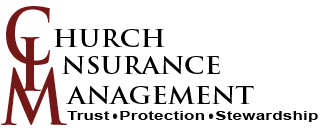Ordinance or Law coverage is confusing to most insurance policy holders. It could be the critical coverage that allows your church to fully rebuild following a loss and it may help keep your congregation in the process. Mitch Smith with the Charles L Crane agency answers common questions about this strangely named coverage.
Ordinance or Law Property Coverage FAQ*
*Frequently Asked Questions
1. What is Ordinance or Law coverage?
Insurance policies covering buildings are typically designed to cover the cost to repair or rebuild your property as it existed before the loss. If you had a 10,000 square foot masonry building that did not have sprinklers before the loss, your insurance company will pay to repair or rebuild your building with one of “like kind and quality”, i.e., without sprinklers.
What happens frequently is that some years after your building was originally built, the city passes a law that all new and rebuilt buildings must have fire protection sprinkler systems. Your basic property insurance policy will not pay for these required changes.
An Ordinance or Law endorsement adds this coverage to your property policy. If, after a covered loss, changes or improvements to your building are required by a local, state or federal law this endorsement will pay for the extra cost.
2. Can you provide other examples?
Yes, here are two real-life examples:
Following the Los Angeles, California – Northbridge earthquake in 1994, many buildings were never repaired because of the requirement to rebuild to earthquake resistant standards. The additional costs were prohibitive for many property owners. In the case of California, the building codes were already in effect but many structures were “grandfathered”. This meant older structures would not be required to meet the newer standards unless a building inspection determined the structure had sustained significant damage. Once this determination was made, any repairs to the structure, or rebuilding would require meeting the current building codes.
And, after Hurricane Katrina, which occurred in 2005, many communities developed new standards for buildings to withstand hurricane force winds or flood damage in the future. For many property owners, this involved extra costs to rebuild with special hurricane roofs, improved foundation anchoring systems, and raised foundations.
3. What are the coverage options for the Ordinance or Law endorsement?
The Ordinance or Law endorsement follows the covered causes of loss form attached to the property policy. It is only triggered when the policy responds to covered direct damage to your building.
The Ordinance or Law endorsement has three coverage options:
• Coverage A – for Loss to the Undamaged Portion of the Building
• Coverage B – for demolition costs
• Coverage C – for the increased cost of construction
4. Can you explain these in greater detail?
A. Loss of Value – Undamaged Portion: Property insurance provides a promise to replace “damaged property” with like kind and quality. However, a building ordinance may require demolition of the portion of a building that did not suffer any damage. This coverage will pay the insured for the “value” of the undamaged part which now must be demolished.
B. Direct Damage – Demolition Costs: This coverage will pay the cost to demolish the undamaged portion of the building and remove debris associated with demolition.
C. Direct Damage – Increased Cost of Construction: An older building which enjoys an exemption via what is known as a “grandfather clause” is often the subject of this coverage. In the event the building is damaged extensively this exemption will become void. Improvements to the building including fire protection, retrofitting the structure to withstand earthquakes, floods or hurricanes, emergency evacuation, handicapped accessibility including exterior ramps for wheelchair access, enlarging bathrooms to accommodate wheelchairs are just a few examples of increased costs associated with rebuilding to current code requirements.
For B & C above, you must choose an amount of insurance to cover these costs.
5. Are there any other options available?
Yes, but it requires another endorsement, separate from the one noted above. This additional endorsement extends the Ordinance or Law coverage to the Loss of Business Income section of your property policy.
6. How can an Ordinance or Law claim increase a Business Income (BI) loss?
The answer is simple. Without this endorsement, BI coverage will only respond to the time it would have taken to restore your building to its original condition. For example, when the time required to rebuild with a sprinkler system increases the loss of income, the additional loss is not covered. Your BI coverage will end at the point your old building would have been completed without the now-needed improvements or revisions. Adding this endorsement to your policy – and assuming you have chosen an adequate amount of insurance on the policy – will extend your BI coverage for the increased time it takes to repair or replace your building to meet the new construction laws.
To learn more about Ordinance or Law coverage and the potential impact a loss could have on your organization, contact the team at Church Insurance Management. We will help you identify the coverage you have and the coverage you need.




